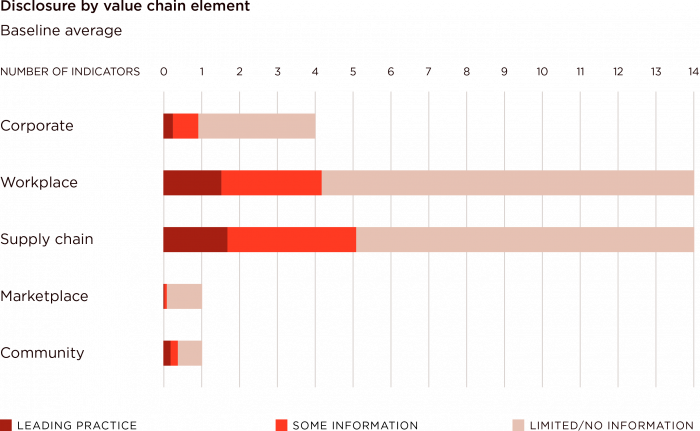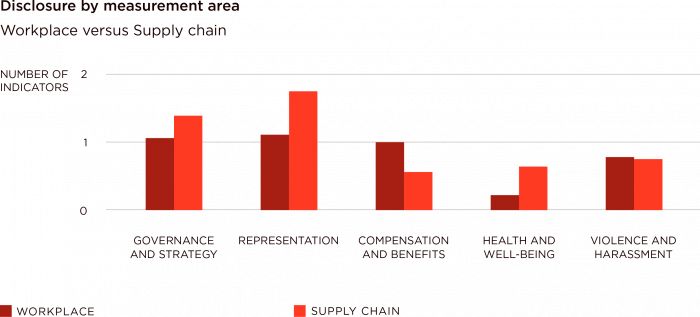Key finding
A strategic approach to gender is the way forward
The apparel industry must recognise the varied ways it can take action and drive change on gender equality and women’s empowerment. However, this requires companies to establish a strategic approach that is both integrated across the full breadth of their value chain and holistic, in that it considers the broader context and various interconnected dimensions affecting gender equality.

Companies that have made a commitment to gender equality and women’s empowerment need to publish more information on the actions they have taken to implement their commitment. For example, of the companies assessed, 12 (33%) have made a public, high-level commitment to gender equality and women’s empowerment, ten of which are signatories to the United Nations Women’s Empowerment Principles. However, only six of these companies have also established specific, time-bound targets that go beyond increasing gender diversity in senior positions.
Stand-alone targets, such as gender diversity in leadership, are a good start for establishing a strategy to drive gender equality and women’s empowerment. However, these often miss key gender impacts in the workplace, supply chain, marketplace and community. Companies need to set targets that take into account their entire value chain and track progress against them, otherwise gender inequalities will remain. To do so, they must collect more data.
Integrating gender will add value to the value chain
A majority of the companies assessed (25 companies, 69%) consider at least three elements of their value chain. However, only two companies (Fast Retailing and H&M) indicate that their gender efforts span all five elements (corporate, workplace, supply chain, marketplace and community). The community element has the highest number of companies that disclose information, with 14 companies (39%) indicating at least three programmes that support women and girls in the communities where the company operates. On the flip side, the marketplace element has only three companies (8%) reporting on how they address non-discriminatory marketing practices to avoid harmful gender stereotypes and engage with their customers. Only one company, Fast Retailing, has taken a more comprehensive approach to address gender in its marketing by becoming a member of the Unstereotype Alliance.
When comparing the workplace and supply chain elements of a company’s activities, 19 companies (53%) disclose more details about what they do to address gender equality and women’s empowerment among suppliers and their workers than for their own employees. This holds especially true for the governance and strategy, representation, and health and well-being dimensions.

Regarding governance and strategy, Levi’s focuses on promoting gender equality in the supply chain, stating that women workers’ basic human needs are often unmet. To address this, the company has established the Worker Well-being initiative that supports supply chain workers’ financial empowerment, health and family well-being, equality and acceptance. Furthermore, it requires suppliers to undertake a worker needs assessment that covers topics such as hygiene and sanitation, sexual and reproductive health and economic empowerment. It is the only company in the assessment that requires suppliers to consult their workers on health and safety needs. However, Levi’s does not indicate that it seeks feedback from its own employees or external stakeholders to inform its gender efforts. Nor does it disclose information on whether it considers the fair representation or compensation of women across its workforce.
In terms of representation, H&M addresses the systemic discrimination that women supply chain workers face, establishing the Women Worker Progression Programme. A collaboration with the International Finance Corporation and Better Work’s Gender Equality and Returns initiative, this training programme supports women sewing workers in Bangladesh to move into supervisory roles. In the workplace, the company states that it offers mentoring and coaching to support employee development but does not specify whether any of these programmes provide specific support for women employees. Similarly, other companies disclose more details around the professional development opportunities offered to women supply chain workers, such as Gap’s Personal Advancement & Career Enhancement (P.A.C.E.) programme and Walmart’s Women in Factories Training Program, than to their own women employees.
For the health and well-being dimension, Ascena Retail Group ensures its supply chain workers have access to gender-responsive health information and services. Through the HERproject led by BSR (Business for Social Responsibility), the company provides health trainings to women workers that cover breast cancer, HIV awareness, menstrual hygiene and nutrition. However, no information was found to suggest that Ascena Retail Group covers any additional costs surrounding the maternal, mental or sexual and reproductive health needs specific to its women employees.
Conversely, eight companies (22%) disclose more information regarding their gender efforts in the workplace than in the supply chain. This is especially the case for compensation and benefits, with 22 companies (61%) publishing details about how they consider the fair compensation of their employees and extend them family-friendly benefits. Only 14 companies (39%) disclose information regarding what compensation and benefits suppliers should extend to workers in order to support their unpaid care burden, which women disproportionately carry. For instance, Kering offers 14 weeks of fully paid parental leave for both women and men employees. It also allows employees to work reduced hours without any loss of pay during the month following their return from leave and offers day-care centres to employees based in France. However, the company does not require its suppliers to offer workers parental leave or childcare support.
Similarly, slightly more companies disclose information about their violence and harassment prevention efforts in the workplace than in the supply chain. In India, for example, Aditya Birla Fashion and Retail applies the Prevention of Sexual Harassment (POSH) framework, which ensures detailed investigations of sexual harassment complaints are conducted by a committee that is a majority female. Furthermore, it adopted the Policy for Prevention of Sexual Harassment at Workplace to provide an effective complaint redressal mechanism if there is an occurrence of sexual harassment. However, no information was found on how the company prevents violence and harassment in the supply chain.
Addressing gender holistically is critical for achieving equality and empowerment
Twenty-one of the companies assessed (58%) disclose information for at least five measurement areas, though only three companies (Fast Retailing, H&M and Aditya Birla Fashion and Retail) reveal details about their gender efforts across all seven, including marketplace and community. Yet even these three companies’ approaches to gender are not without discrepancies. For instance, Fast Retailing addresses gender in its governance structure and strategy as well as engages with internal and external stakeholders to manage and improve its gender impacts. However, the company does not show as much consideration for the fair representation of women in the workforce, with no women among its board members or senior executives. Similarly, Ralph Lauren displays strategic action on gender by setting specific, time-bound targets to increase the number of women in senior leadership in the workplace. However, no information was found regarding the professional development opportunities that the company offers to women employees.
Other companies, such as Inditex and VF Corporation, consider the fair representation of women though do not explicitly address their fair compensation. Moreover, there are companies, namely Aditya Birla Fashion and Retail and Under Armour, that take action to prevent violence and harassment but reveal little information about their gender efforts across other dimensions.
One way for companies to ensure that they develop a strategic approach to gender that is both integrated and holistic is to engage relevant stakeholders on gender-related issues and incorporate their feedback into company policies and practices. The women affected by the apparel industry can be found in the workplace, supply chain, marketplace and community, and they are impacted across multiple dimensions. However, companies cannot know whether these women are fairly considered and truly empowered until they ask.